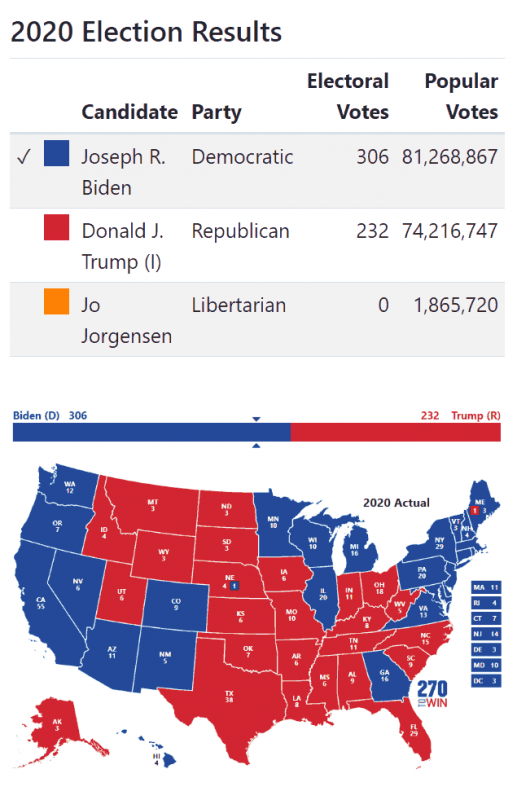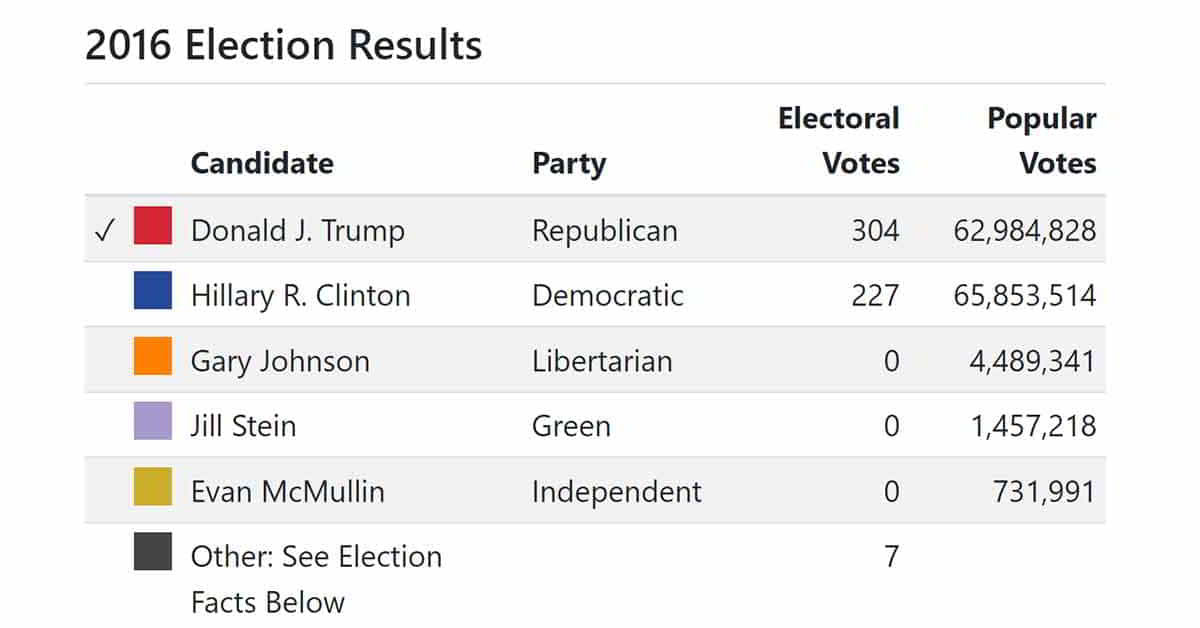
In less than two months, Americans of the United States of America go to the polls to elect a new President–and to replace the legislators whose terms are up–through a racist election system that could again hand the presidency to Donald John Trump.
In the 2016 Presidential election, the Democratic candidate, Hillary Rodham Clinton, won the popular votes but the Republican candidate, Trump, won the election. That outcome, however, was not the first one in their long history of presidential elections. As recently as 2000, George W. Bush (“Bush Junior”), another Republican, also lost the popular votes but won the election.
If we accept elections to be an exercise in a democratic process, then the US presidential election system is undemocratic. The reason is no other than the Electoral College System.
In the Electoral College system the vote of a White American has more weight than that of a non-white American–such as an African-American or (non-white) Hispanic American or an Indian American or a Native American etc. The Whites, therefore, have more power, which is also demonstrated by the composition of the 100-strong Senate.
US Congress and the Electoral College
To understand the Electoral College system, we have to start with the legislature of the United States, the US Congress. It is made up of two bodies: The Senate, the upper chamber, and the House of Representatives, the lower chamber.
The Senate is composed of one hundred Senators–two from each of the fifty States. That means a State’s pair of Senators represent just 2% of the Senate in every case. Territories, such as Puerto Rico, American Samoa etc. as well as the District of Columbia have no representation.
The House, on the other hand, consists of 435 voting members from the fifty States and six non-voting members from the territories. Unlike the Senators, their numbers vary from one State to another; broadly speaking, the higher the population of a state, the higher the number.
The most populous State of California, with an estimated population of almost thirty-nine million, for instance, will be represented by a total of fifty-two House of Representatives in the 119th Congress. Tennessee, with a population of about seven million, will be represented by a total of nine House of Representatives. The least populous State of Wyoming, with about half-a-million, on the other hand, will be represented by just one House of Representative. See the charts below for 1. the proportions of the state population relative to that of the nation and 2. the proportion of the House Representatives relative to that of the total (435).
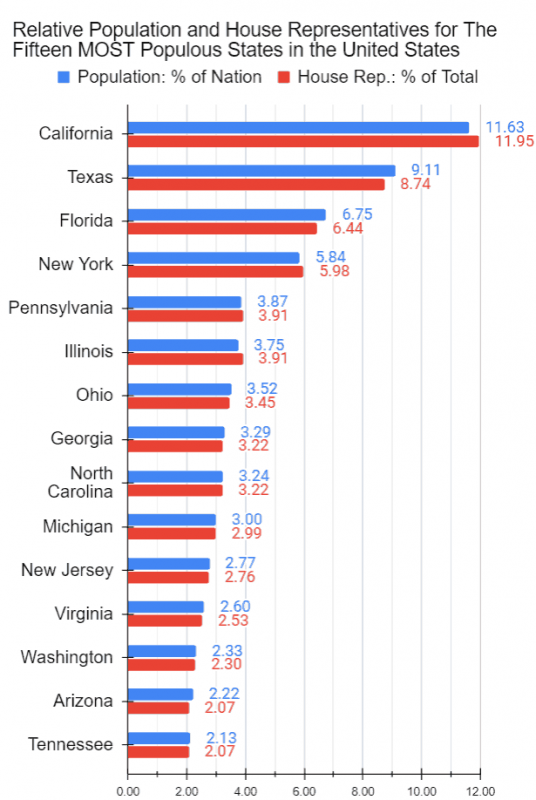
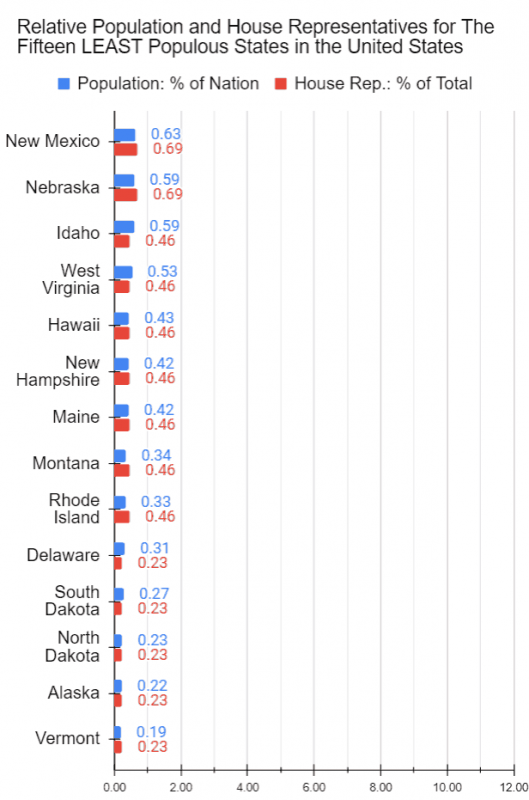
The Electoral College, also referred to as the Delegates, is a body made up of the same number of members as the total number of Congressmen plus three, 538. The Congressmen themselves are NOT, or rather do NOT function as, the Electoral College. Who do the additional three represent? District of Columbia, which, though NOT a State but where the capital city of Washington is located, is allowed representation in the body.
Not surprisingly, the Electoral College representing a State are not only NOT proportional representation of the population, there’s a pattern in their proportion too (see chart below).
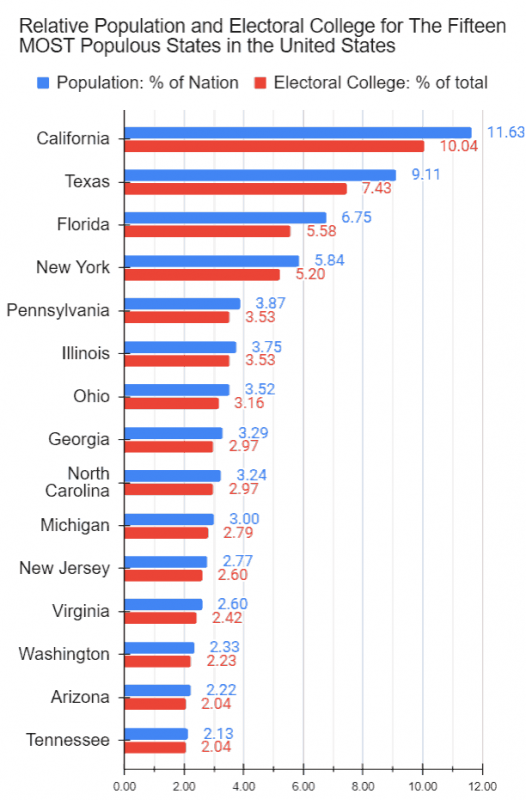
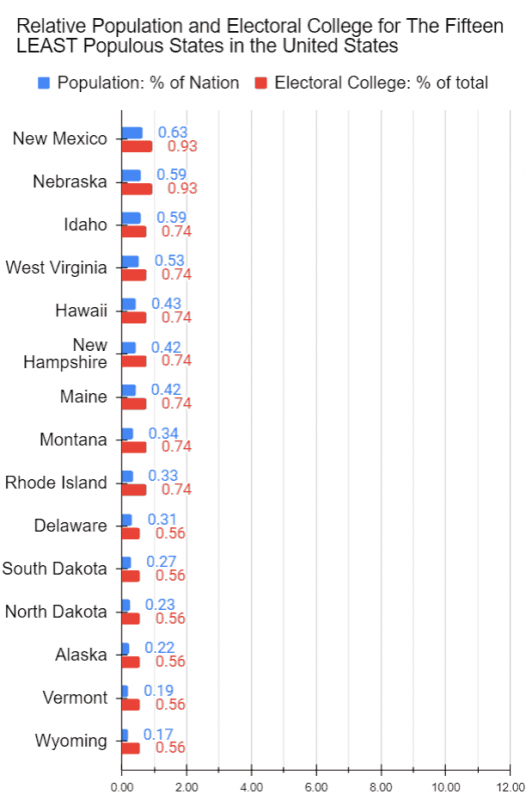
Please note that, in the discussions that follow, the figures quoted as the population of different States are assumed to represent citizens of the United States, which they are NOT because of the way census data is collected. Of course, using and quoting eligible voters where relevant would have been better BUT because I was unable to find that demographic broken by race, I couldn’t do that.
If NOT already obvious, the histograms show that the number of legislators representing a State and therefore state Electoral Colleges are NOT proportional to its population and that is the MOST IMPORTANT point to remember, about which I’ll have more to say later.
Electoral College System of Presidential Election and Racism
You may have heard of “American Exceptionalism” which, not surprisingly, also extends to the way they elect their President! The process is long and a number of steps are involved. While all of them might be unusual to all but Americans, what is exceptional however is that it culminate in TWO voting processes. The first of them is the casting of votes by the registered voters for their preferred candidate in their State of residence–in person on election day in early November or by mail. That, of course, in and of itself is not that unusual.
What is very American is the second and final step: the casting of the votes by the State Delegates, the Electoral College. They do so in their State capital on a day not long after the election day. They cast their votes for the candidate that won the popular votes in their State–at least that’s how they are supposed to vote but they don’t always do that. The ballots the registered voters cast, in other words, is actually to tell their State Delegates who to vote for on their behalf.
If, for instance, a majority or plurality of voters in California cast their votes for the Democratic candidate, then their fifty-four Delegates (are supposed to) caste their electoral votes for the Democratic candidate. Similarly, the nine delegates from Tennessee and the three from Wyoming are supposed to do the same.
So, what’s the problem? The problem is that the winner of the election is decided by the votes caste by the Delegates–the one that gets 270 electoral votes out of the 538–and NOT by the registered voters. (Another minor problem that has already been hinted at is the fact that individual Delegates don’t necessarily vote in line with the result of the statewide popular votes.)
Since the Delegates are NOT proportional representation of the population, firstly, a candidate can end up with 270 or more Electoral College votes without a plurality or majority of national ballots, and, secondly, because of the variation in the populations of the States, they favor the Whites, which I’ll have more to say later. Coupled with that, more often than not, the “swing states”–the crucial ones of which are populated more by Whites than not–end up determining the outcome.
To demonstrate what I mean, let’s first have a look at the numbers from the 2016 election where Trump won the election in spite of getting 2.1% lower popular votes (see image below).
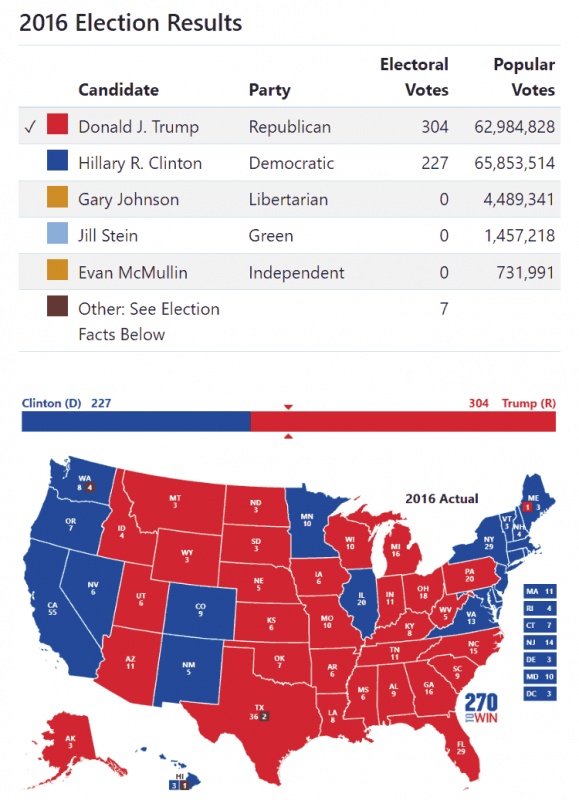
Here’s a more informative map also from the same source as above.
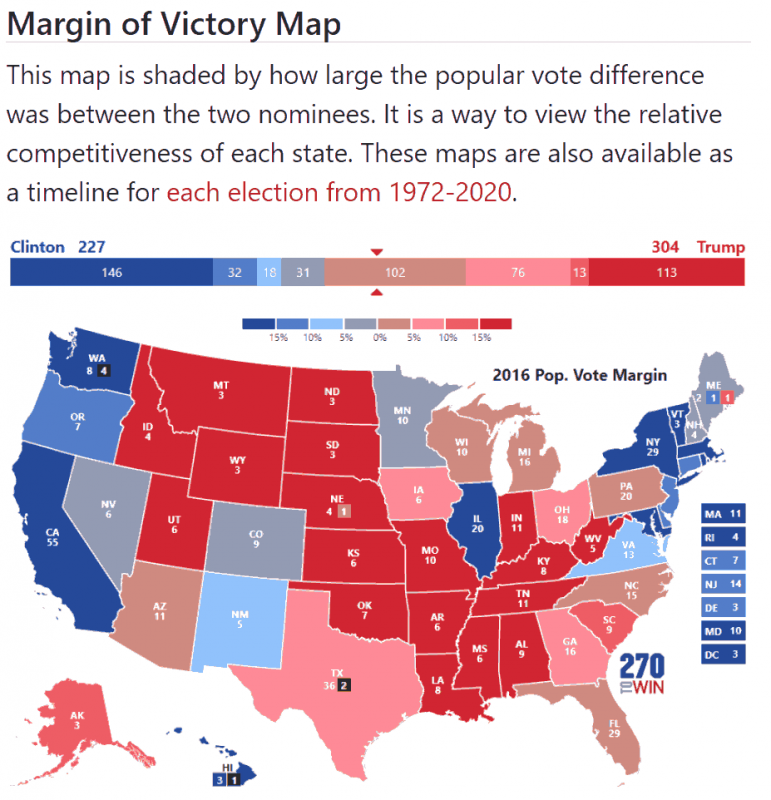
As you can see from the above map, in the 2016 Presidential Election cycle, there were states that clearly sided with the Democratic (deep Blue) or Republican (deep Red) party. Those are the ones with a popular vote margin of 15% or more. There were also States where the margin was small, less than 5% (light blue and light pink). The reasons for those results are simple: there are States that consistently lean towards one or the other party as well as those that don’t and so go back and forth.
In the last nine Presidential Election, twenty States and Washington, DC have CONSISTENTLY voted for the same political party (see map below).
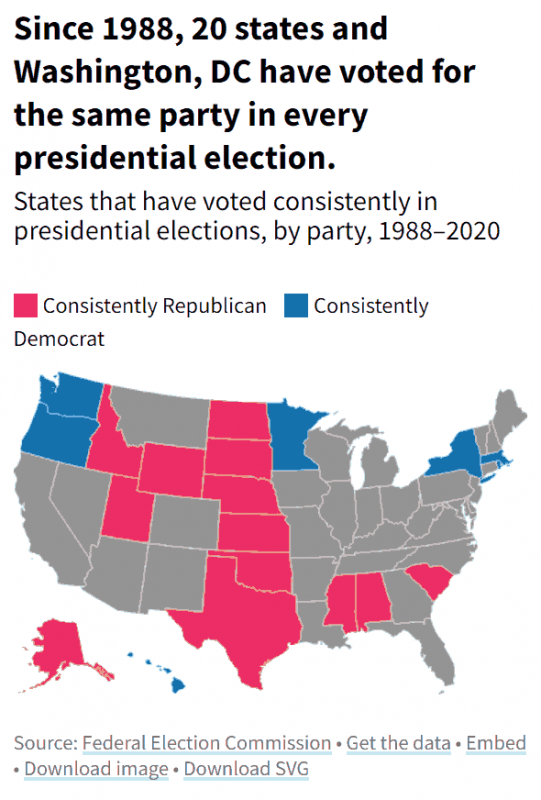
What about the rest, the ones shaded in grey in the above map? That brings me to the idea of swing states.
Swing States
Swing states are ones where the voter allegiance to one party or the other is not guaranteed from one election cycle to the next. The following histogram shows the number of swing states by election year and, as you can see, the last few decades have seen quite a bit of variability in their numbers.
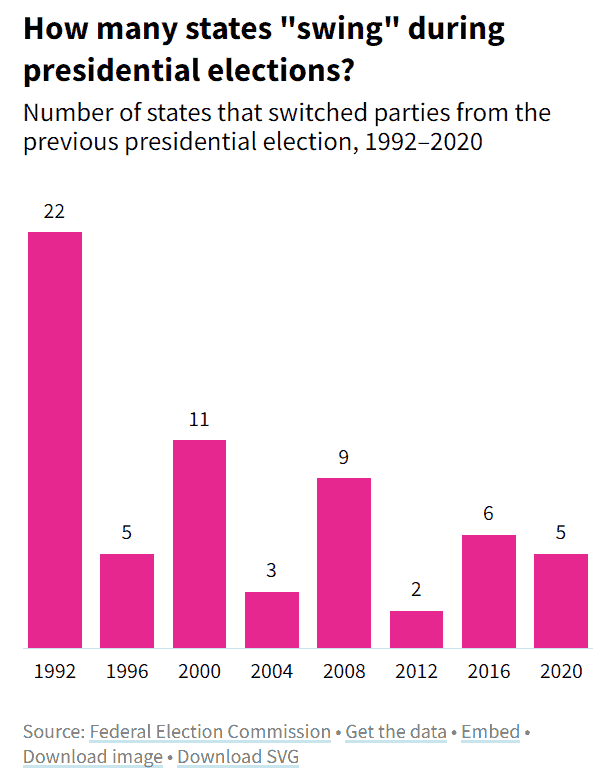
Focusing on the 2016 election, the six swing states were Florida, Iowa, Ohio, Michigan, Pennsylvania and Wisconsin. In 2024, the States likely to determine the outcome are predicted to be Arizona, Georgia, Michigan, Nevada, Pennsylvania and Wisconsin.
In fact, from 1992 onwards, “26 states were won by less than a three-point margin in at least one election.” That is, the Electoral College system of presidential election can end up being a really tight one especially so in a number of battleground States, that is, in the swing states.
Why the Electoral College is Racist: The Numbers
Now we can go back to tackling the question of why the Electoral College system of Presidential Election in the United States is a racist one. The bottom line is that, because the state Delegates are not proportional representation of the population, the value of a White vote is more than that of a non-white vote and so, not surprisingly, who becomes the President is decided more by the Whites.
Let’s go back to the three States California, Tennessee, and Wyoming with thirty-nine million, seven million, and half-a-million in population, and, in 2024, will be represented by fifty-four, eleven, and three Delegates respectively. So, a Delegate for each of the State represents about 722K, 648K (histogram 1 below), and 195K (histogram 2 below) of their population respectively.
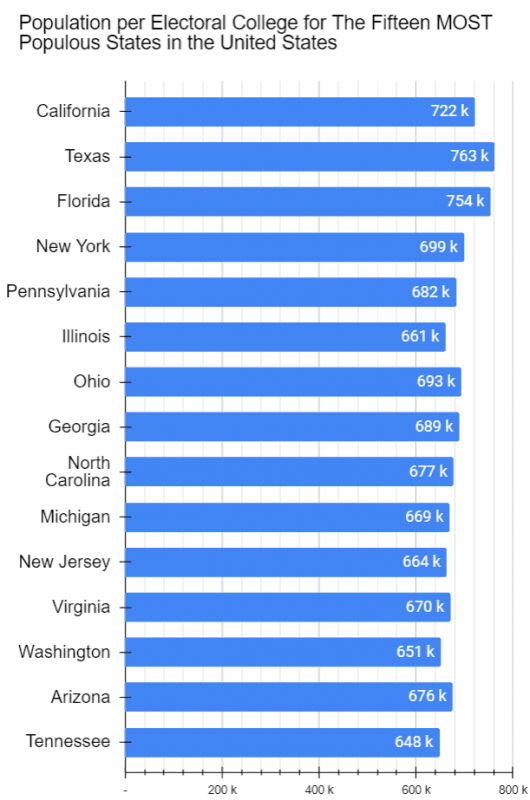
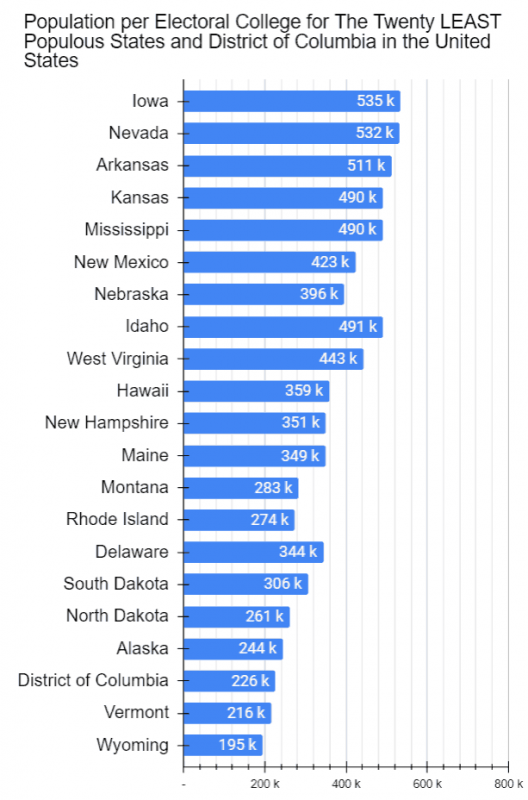
Firstly, notice how different they are. Secondly, assuming the proportion of registered voters in the three are similar to the proportion of their populations, notice how a Delegate’s vote in Wyoming represents a fraction of the population than those in California and Tennessee. Thirdly, notice how there’s also a difference between California and Tennessee.
Here’s the crucial information however: California is not only so massively more populous than either Tennessee or Wyoming, it’s also the state with the second lowest proportion of White population after Hawaii (see histogram 2 below). At 36%, the proportion of White population in California is less than HALF that in Tennessee (74%) and much less than half that in Wyoming (84%) (see histogram 1 below).
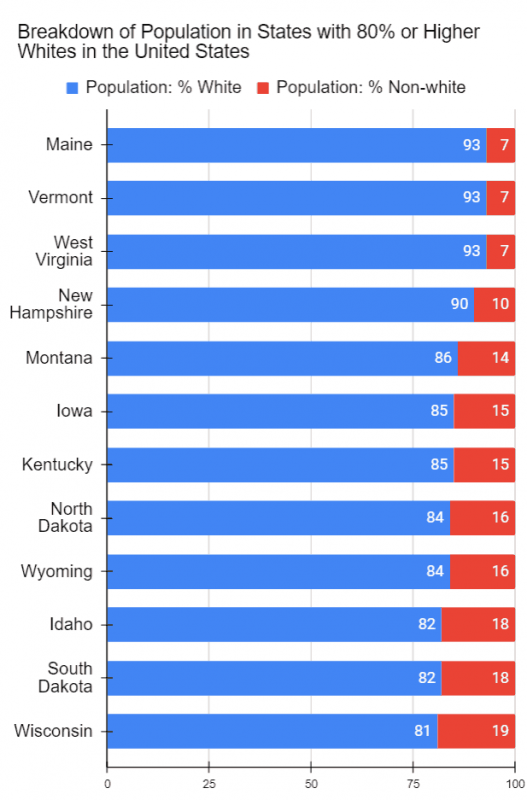
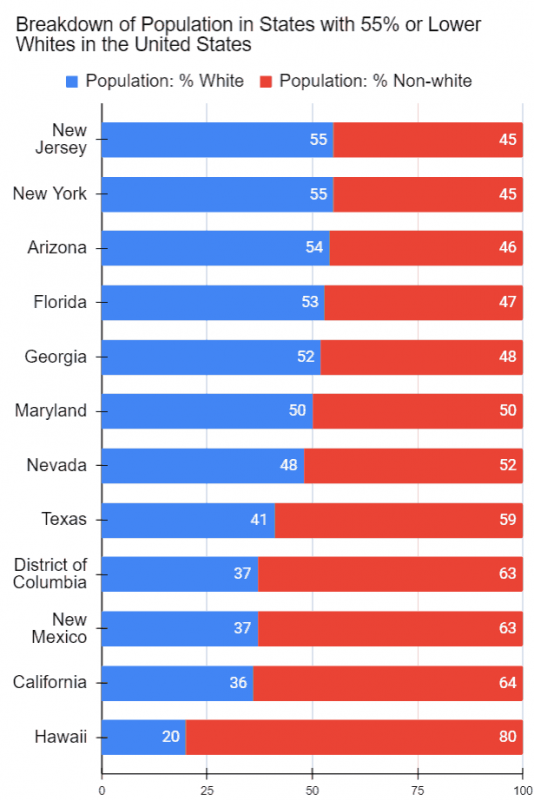
In other words, almost 2-in-3 in California is non-white while in Tennessee that number is just about 1-in-4 but in Wyoming that’s less than 1-in-5! And, it does NOT take a genius to conclude how the value of a vote in the three States does NOT compare at all, but there’s more of course.
In fact, Electoral College per million population in Wyoming’s case is 5.1 much more than twice that of California at just 1.4 (see histograms below for more).
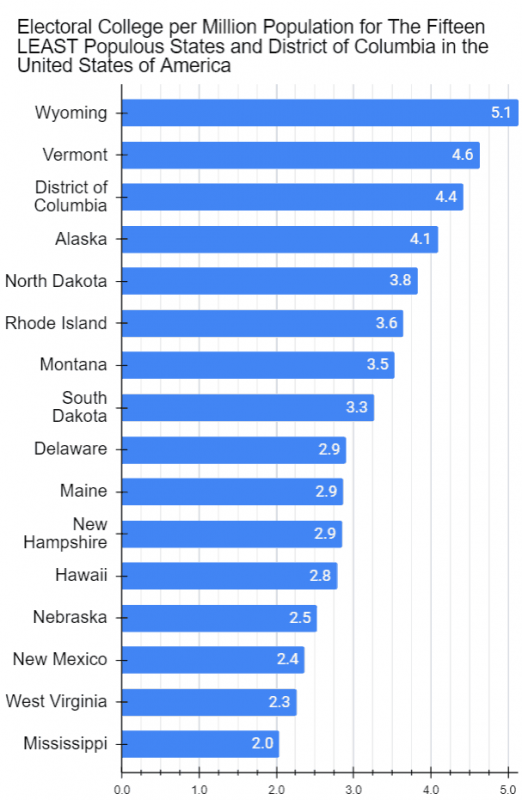
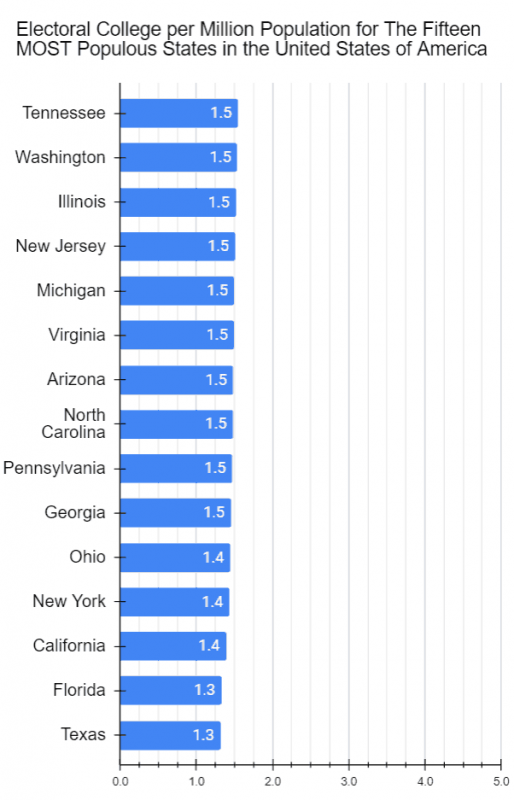
So, in spite of a vote from a voter being counted as one vote, the votes of those states with very large White population have more value than those of the others in the Electoral College system.
Furthermore, California, Texas, Florida, and New York are the four most populous States. With populations that are 64%, 59%, 47% and 45% non-whites respectively, their populations are also considerably more diverse than most others. In fact, their combined total population (112 million) is more than the combined total population of the twenty-seven Whitest states (109 million) (see histogram below).
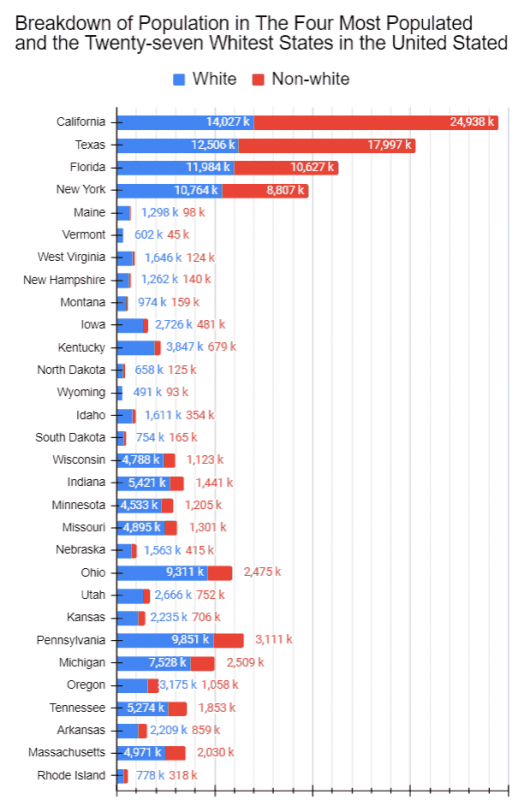
However, the Delegates for the four most populated states number only 152 while for the twenty-seven Whitest states they number 195 (see histogram below)!
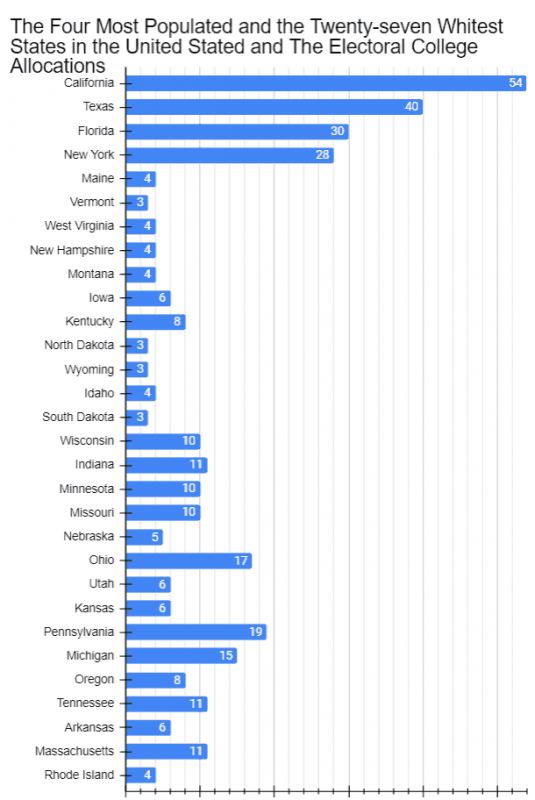
To reiterate the bottom line, White votes in the Electoral College system of election in the United States count more than non-white votes.
But then you are probably thinking, “So, what?! The result of the election is determined by the swing states as you have stated above anyway.” Well, let’s have a look at them. Here are the 2016 and the projected 2024 swing states and their relevant data.
| 2016 Swing States | Population/Million | % White | Electoral College |
| Florida | 23 | 53 | 30 |
| Iowa | 3 | 85 | 6 |
| Ohio | 12 | 79 | 17 |
| Michigan | 10 | 75 | 15 |
| Pennsylvania | 13 | 76 | 19 |
| Wisconsin | 6 | 81 | 10 |
| 2024 Swing State | Population/Million | % White | Electoral College |
| Arizona | 7 | 54 | 11 |
| Georgia | 11 | 52 | 16 |
| Michigan | 10 | 75 | 15 |
| Nevada | 3 | 48 | 6 |
| Pennsylvania | 13 | 76 | 19 |
| Wisconsin | 6 | 81 | 10 |
NOT every swing state, as you might have expected, is overwhelmingly populated by Whites (for example, Georgia and Nevada) nor are they relatively small (for example, Florida). But, enter voter suppression, which make significant impact on the outcome of elections, specifically in swing states, naturally.
The results of elections of the president and of the congressmen are also influenced by voter suppression tactics, such as gerrymandering, state rules and regulations around voter eligibility and voting, the number of polling stations, voter registration, voter purging etc. etc. Voter suppressions tactics are employed more by the Republican Party than the Democratic Party and mainly target and/or disadvantage non-whites and therefore, again, racist. Non-whites, especially the African-Americans, generally lean Democratic.
There’s been sufficient documentations, including by the investigative journalist Greg Pallast, which demonstrate that elections in the southern State of Georgia where 31% are African-American, for example, have consistently suffered from voter suppression tactics and only NARROWLY went Democratic in 2020 after voting Democratic only once (in 1992) in the preceding nine presidential elections!
The Senate: Another Evidence for the Racist Election System
Let me once again remind you of the fact that the upper chamber, the Senate, consists of just 100 members, two from each of the 50 states. What that means is that, in the case of California, each Senator represents 19.5 million Californians. In Tennessee’s case, a Senator represent only 3.6 million Tennessean. In Wyoming’s case, a Senator represents only a quarter of a million Wyomingite. Since every single one of the 100 Senators has the same legislative power, that basically amounts to unequal representation–or rather lack of adequate representation for the non-white population of the United States. See histograms below for more.
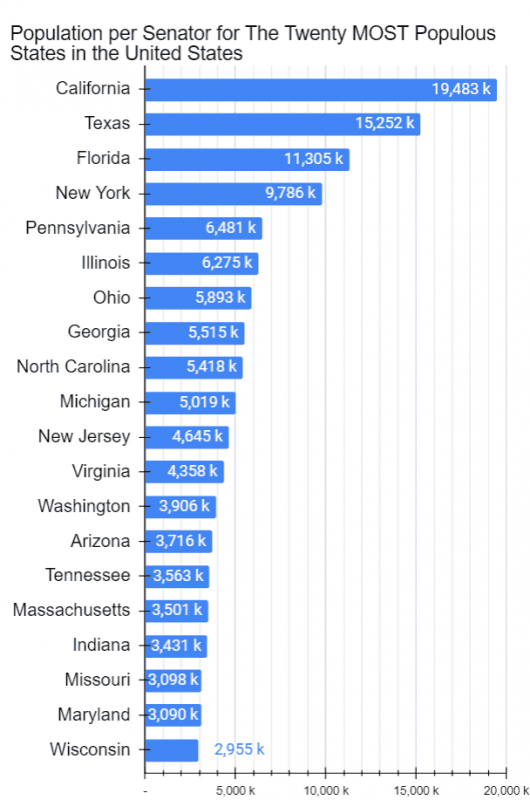
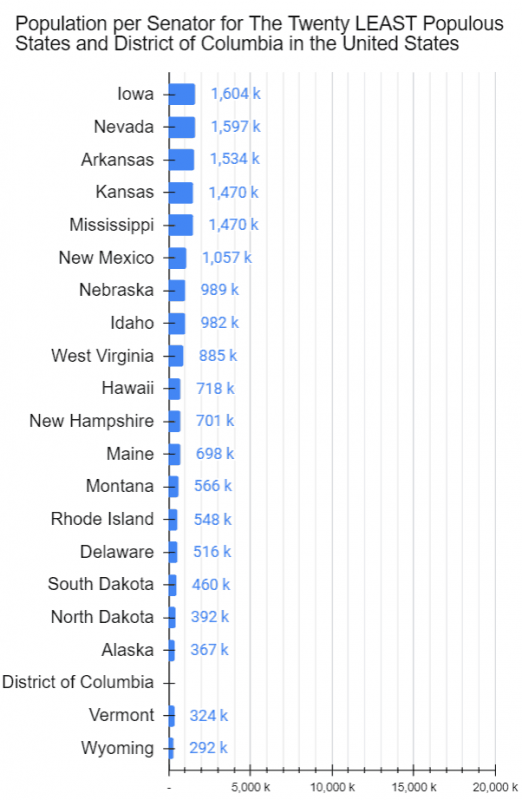
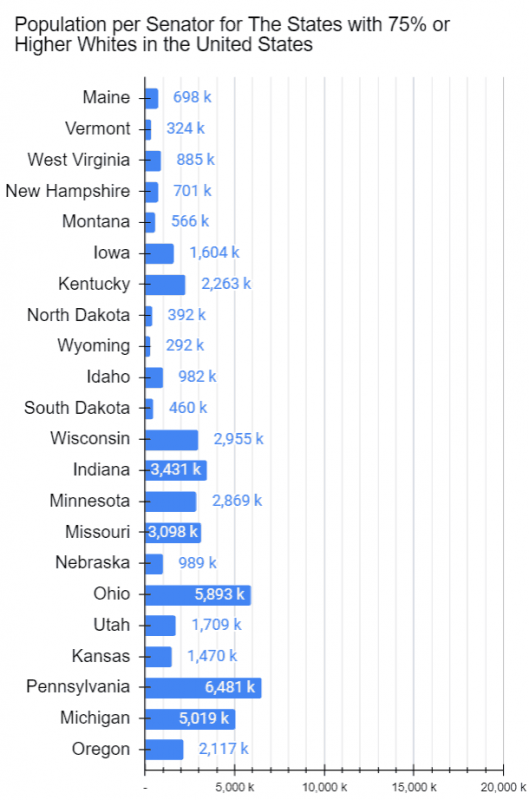
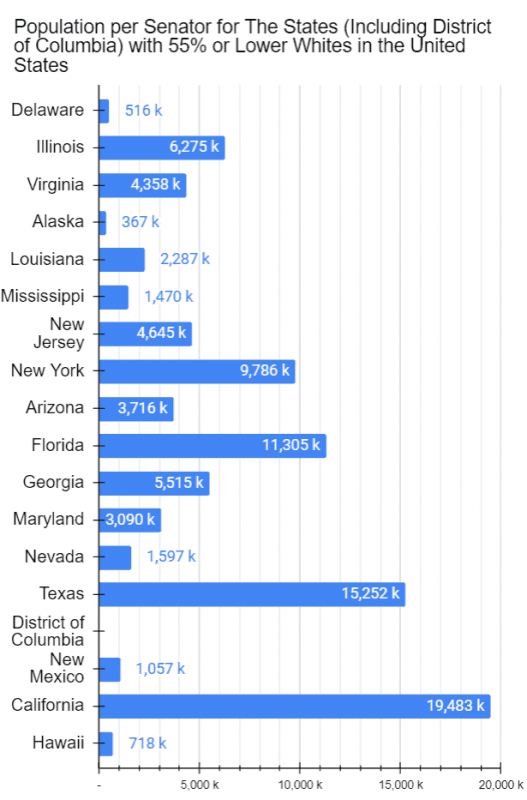
Returning to California, Texas, Florida, and New York, states with the highest and some of the most diverse population…. They have a combined total population of about 112 million but are represented in the Senate by just eight Senators. The twenty least populated States with a combined total population of about 59 million–about half of those four–on the other hand, are represented in the Senate by fifty-two, which is almost seven times more!
Similarly, the twenty-seven whitest states with a combined total population of about 109 million are represented in the Senate also by fifty-two, again, almost seven times more!
In other words, not only is the value of an Electoral College vote in States with relatively low population and dominated by Whites higher than in others, such states, not surprisingly, are also disproportionately highly represented in the Senate.
Here’s one of not very surprising consequence of all that in the current Senate. The upper chamber is equally split between the Democrats and the Republicans, BUT
“[i]t’s worth highlighting just how much of an advantage Republicans derive from Senate malapportionment. In the 25 most populous states, Democratic senators…hold a 29-21 seat majority […]. Republicans, meanwhile, have an identical 29-21 majority in the 25 least populous states.
“The 25 most populous states contain nearly 84 percent of the 50 states’ total population. So 16 percent of the country controls half [–fifty–] of the seats in the United States Senate (and that’s not accounting for the fact that DC, Puerto Rico, and several other US territories have no representation at all in Congress).”
The Vox article goes on to point out how the “the Democratic half of the Senate […] represent 41,549,808 more people than the Republican half.” That works out to about 12% of the population of the country!
One of the main reasons for that is that, again, small states with very high White populations are more likely than not to be conservative and therefore Republican leaning.
Trump and 2024
Now, to finally get to the point about how Trump could come out victorious in 2024….
In 2016, Trump won in all six swing states of Florida, Iowa, Ohio, Michigan, Pennsylvania and Wisconsin. But, in only two cases did he win a majority of the popular votes: Iowa and Ohio. In the three DECIDING cases of Michigan, Pennsylvania, and Wisconsin, the margins were slim. Trump won Michigan by 0.2% (10,704 votes), Pennsylvania by 0.7% (44,292 votes), and Wisconsin by 0.7% (22,748 votes). In other words, while Clinton received almost 3 million more popular votes, Trump won the election with 77,000 votes cast in JUST those three States. Another way of restating that is to say that he won because of the racist Electoral College system of presidential election.
Also in the 2020 election, Biden won the popular votes by a clear margin of 4.5% representing over 7 million votes–equivalent to more than the total combined populations of the eight least populated states.
The race, however,
“in three crucial states—Georgia, Arizona, and Wisconsin—was [so] harrowingly close [that had] a total of [just] 43,000 Biden voters in those states […] not voted in the election, Trump would have won a second term under the rules laid out in our Constitution.”
If that wasn’t bad enough, a modeling has shown, at the extreme end, “a Republican victory even in elections where Democrats win the popular vote by up to about six [percentage] points.”
So, Trump just needs to win some swings States with or without the help of some voter suppression tactics and/or the third party candidates stealing some Democratic votes and, potentially, some Electoral Colleges. That is NOT to say that I hope he does. On the contrary; I hope he doesn’t. I know the kind of man Trump is and remember very well his first term in office. In fact, one of his many actions as the President prompted me then to even publish an open letter.
With Joe Biden bowing out and Kamala Harris replacing him, given the latter’s apparent surge in the polls and the apparent enthusiasm of voters for her candidacy, it’ll be a tough fight for Trump. But then again, in spite of all the major polls and pundits predicting a Clinton victory in the lead up to the 2016 election, Trump emerged victorious…again thanks to the racist Electoral College election system!
Anyway, to conclude, it appears to me that, what the Electoral College system of election was meant/intended to prevent way back then by those who created it, in a way has actually enabled it in 2016…though MAGA voters might disagree! What’s more, it will likely continue to do so in the future unless there’s some major changes to the system.
What do you think?
References
- Click here for the source of State population data and here for their breakdown by race.
- The many processes and stages involved in the Presidential Election in the United States is quite long and involved. Click here to read about them.
- “The Senate does not simply give extra representation to small states, it gives the biggest advantage to states with large populations of white, non-college-educated voters — the very demographic that is trending rapidly toward the GOP.” Click here for more.
- Click here for a twitter thread about the electoral college and the issues with it.
- Click here or here for some of the details of why the US ended up with the Electoral College system of Presidential Election as well as that of the members of the upper chamber.
- “The stain of slavery is on the Electoral College as it is on all US history. The formula for apportioning congressmen, which is directly tied to the number of electors, relied at that time on the 3/5 Compromise, whereby each slave in a state counted as fraction of a person to apportion congressional seats. This gave states in the South with many slaves more power despite the fact that large portions of their populations could not vote and were not free.” Click here for more.
- Robert Reich on Twitter on why the Electoral College system of election is racists.
- Robert Reich on Twitter with a solution to the Electoral College system of election.
- Click here for an excellent thread on Twitter for the details of how the 2016 Presidential Election was indeed rigged…in favor of Donald J. Trump.

